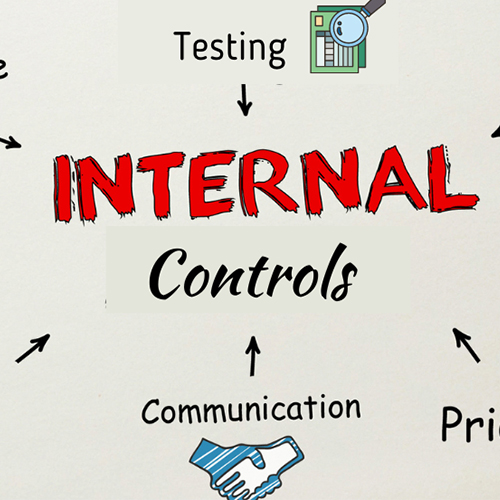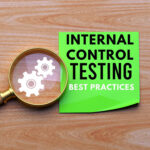This blog emphasizes the importance of control testing in banks and financial institutions, highlighting its role in detecting risks, ensuring compliance, and optimizing internal controls. It explores key methodologies like walkthrough testing and data analytics, and provides best practices for implementing an effective control testing program. By leveraging these strategies, institutions can strengthen their risk management frameworks and safeguard against financial and operational risks.
Internal controls help banks and financial institutions detect mistakes, fraud, and non-compliance, and reduce risks. In addition, control testing plays a vital role in assessing these internal controls and is critical to ensure they are working as intended.
With effective control testing, banks can determine the existing and emerging risks, gaps, and weaknesses in the internal controls and update them to mitigate several types of enterprise risks. It also helps banks and financial institutions safeguard their business against potential risks, such as financial fraud, asset loss, or discrepancies in financial reporting. It ensures that the organization meets the regulatory laws and compliance obligations.
Control Testing Methodologies to Mitigate Risks
Control testing methodologies vary based on the risks faced by banks or financial institutions. Below are some common methodologies and approaches that banks can employ to test internal controls.
1. Walkthrough Testing
The Walkthrough testing method involves tracing the transaction path or process from the beginning to the end. It ensures that all the controls are working effectively. It also provides a comprehensive understanding of internal control and helps find any vulnerabilities or gaps in the controls that organizations can promptly fix and strengthen their internal controls.
2. Evaluate Key Controls
Another methodology is the testing of the key controls. Banks identify controls that are most critical in mitigating risks and focus their testing efforts against these controls. By testing key controls, banks can efficiently allocate their resources and prioritize areas that pose the highest risks. These key controls include:
-
- Internal Controls for Financial Reporting
- AML and KYC controls
- Credit risk management controls
- Information security and cybersecurity controls
- Compliance controls
- Operational risk management controls
3. Compliance Control Testing
Compliance control testing is an essential process component of internal control testing in the banking and financial services sector.
It involves assessing the effectiveness of internal controls to ensure compliance with regulatory requirements and industry standards. It focuses on areas, such as
- Anti-money laundering (AML)
- Know your customer (KYC)
- Data privacy and information security
4. Risk-based Control Testing Approach
With risk-based testing (RBT), banks can test their internal controls based on the possibility of risks and failure of internal controls. They can then create internal control tests to analyze the internal risk controls and tweak or update the controls to mitigate risks.
5. Data Analytics and Automated Testing
Banks and financial institutions can leverage advanced data analytics tools to analyze large volumes of data and identify anomalies or patterns that may indicate potential risks or control failures.
This enables banks to perform more efficient and effective control testing and identify gaps or weaknesses in internal controls in near real-time. This helps them detect and address risks promptly.

5 Key Steps to Implement Control Testing Program
To implement an effective control testing program, banks, and other financial institutions can follow these key steps:
Step 1. Identify Key Risk Areas
The first step is to identify the enterprise risks. Banks should conduct an extensive risk assessment of the organization and processes to identify the key risks they face. This will help:
- Analyze and find risk areas that require controls
- Prioritize testing efforts as per the level of risk
Step 2. Develop and Perform Control Testing
After identifying the risks, develop a ‘Control Testing Framework’ to conduct control testing activities. One can also use a framework, such as:
- COSO
- ISO 27001
- IT General Controls (ITGC) frameworks, including COBIT, NIST, etc.
These frameworks outline the objectives, scope, and control testing methodologies for effective control testing.
Step 3. Evaluate Findings
After performing control testing, evaluate the key findings and identify control vulnerabilities and deficiencies. They also need to assess the severity and impact of these deficiencies and prioritize remediation efforts.
Step 4. Implement Corrective Actions
Develop and implement corrective actions to address control deficiencies. This may involve:
- Revising policies, procedures, and practices
- Enhancing training programs
- Implementing intelligent digital solutions.
Step 5. Monitor and Review
Control testing is an ongoing process, and banks should establish mechanisms to monitor and review the effectiveness of controls regularly. This includes:
- Periodic retesting of controls
- Continuous improvement of the control testing program

Best Practices for Control Testing
To ensure the effectiveness of control testing, consider the following best practices:
1. Risk-Based Approach
Risk-based approach control testing helps banks and financial institutions focus on high-risk areas that can have a significant impact on the bank’s operations.
2. Independent Testing
To ensure objectivity, reduce the risk of bias and conflict of interest, set up a team or assign an individual to test controls independent of the processes being tested.
3. Continuous Control Monitoring
Control testing should be complemented by continuous monitoring mechanisms, such as automated alerts and exception reporting. This allows for real-time identification of control failures and timely remediation.
4. Documentation and Reporting
Banks must maintain documentation of control testing activities, including:
- Test plans
- Test results
- Remediation actions
This document provides evidence of control effectiveness and supports regulatory compliance.
5. External Audits
Banks should consider engaging external auditors for independent assessment of their control testing program. This provides independent reviews of the banking operations and internal controls and helps identify blind spots or areas for improvement that may be overlooked by the internal stakeholders.
Conclusion
Control testing plays a crucial role in banks and financial institutions to find vulnerabilities and fix them to mitigate risks and meet compliance effectively. Through methodologies discussed in this blog, such as walkthrough testing, banks can identify weaknesses and improve the internal controls or redesign them to address the issues that bypassed the preventive controls.
Anaptyss as a strategic partner helps banks identify risks and co-create effective internal controls and enterprise risk management frameworks with a systematic approach, including risk identification, testing design, performance assessment, evaluation, and remediation. Anaptyss enables banks to address challenges like limited resources, regulatory shifts, technological constraints, and resistance.
Interested in learning more about the internal control testing program implementation? write to us: info@anaptyss.com.


















